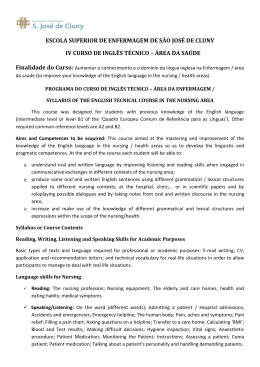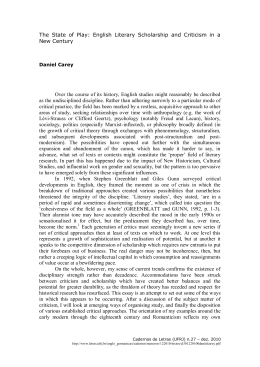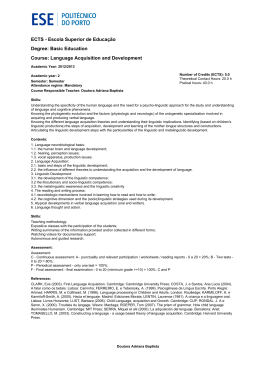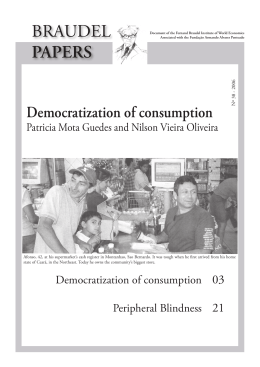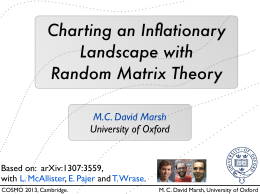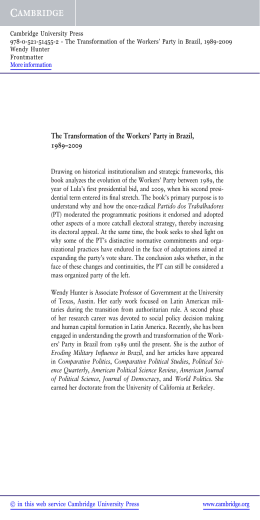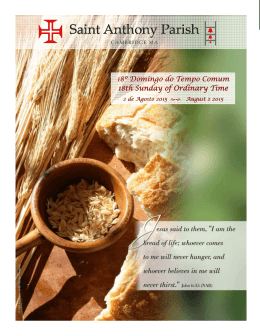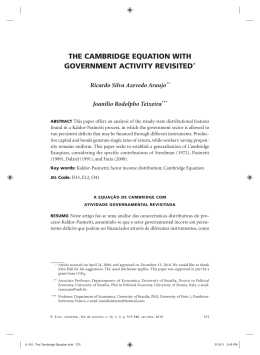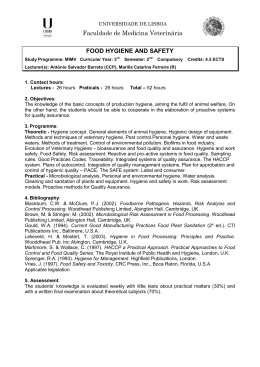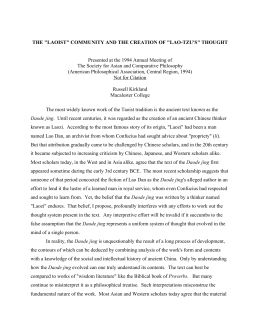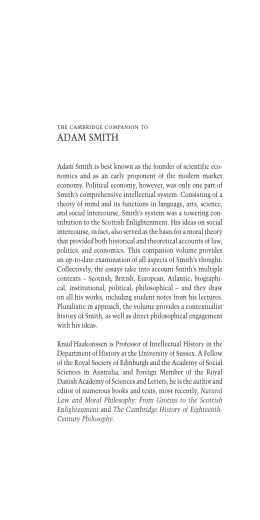1 From Cultural History to Histories of Cultures1 By Peter Burke I am very glad to return to Pamplona, some years after participating in your third colloquium. The topic too is extremely welcome to me as a sign of growing interest in cultural history, even if we do not know or do not agree what cultural history is. Let us hope that by the end of the conference we will at least understand better why we do not agree. In this overture to the themes of the next few days, what I am offering is a historiographical account, the story of a sequence of different points of view or positions in a debate, or paradigms of cultural history. Needless to say the participants in the debate cannot be confined to professional historians; the conversation about cultural history has been as interdisciplinary as it has been international. What I shall do is focus on a few moments in a few countries, (employing the idea of ‘moment’ as it was used in the circle of the literary critic Frank Leavis in Cambridge).2 I shall privilege five such "moments"; German, Anglo-Hungarian, French, North American and finally Ibero-American, each of them corresponding to a different approach to cultural history, a different model. A true history of these moments would have much to say about the relation between each approach and the cultural and social environment in which it was developed. In this overture, however, I shall concentrate on what is distinctive about each and what may remain useful for us today. Of course there was much overlap between these rather long moments. It is equally obvious that many other countries were involved in these movements. All the same, the areas named above have all been central at one time or another to the development of certain forms of cultural history. Economic historians often tell a story of international leapfrog, a certain region overtaking its predecessor, only to be overtaken in its turn. 2 Such a simple story cannot or should not be told in the case of cultural history, since its goals as well as its methods have changed over time. All the same, different views of cultural history have often taken the form of responses to earlier positions, and regions peripheral to a given tradition have often found it easier to liberate themselves from it than the old metropolis with its high intellectual investments in that tradition. In what follows I shall privilege one story: from the history of culture in the singular to histories of cultures in the plural. It would have been possible to choose other themes, for example the shift from Geistesgeschichte to the history of the body, but that topic will have to wait for another occasion. 1. The German moment. Germany, or the German-speaking world, has had a relatively long tradition of cultural history, especially strong from the time of Jacob Burckhardt (to be discussed by Lionel Gossman below). A cultural history closely linked to the hermeneutic tradition from Schleiermacher to Wilhelm Dilthey. Within this tradition, I should like to underline the importance of a circle of scholars working in Hamburg at a particular moment, the 1920s, around Aby Warburg and his library, which later turned into the Institut für Kulturwissenschaften and still later into the Warburg Institute. Warburg himself devoted his life to the study of the classical tradition and its transformations.3 Ernst Cassirer was then working on ideas of the individual and the cosmos during the Renaissance. Erwin Panofsky was developing what he called his "iconological" approach, which might be regarded as another name for Geistesgeschichte. Panofsky's concern to capture the spirit of an age in its parallel manifestations is particularly clear in his essay on Gothic architecture and scholasticism.4 As for his famous distinctions between three levels of the interpretation of images, the pre-iconographical description, the iconography 3 and the iconology, it is a translation into visual terms of distinctions made within the hermeneutical tradition.5 The famous study of "the representation of reality in western literature" by Erich Auerbach may also be placed in the traditions of hermeneutics and Geistesgeschichte, despite the author's attempts to distance himself from it - for the book depends on the assumption that the fragments of texts which begin each chapter reveal the character of the whole culture of their epochs.6 Within this tradition there was an implicit emphasis on "the" history of "culture" (usually identified with western high culture), sometimes contrasted, as in the work of the sociologist Alfred Weber (Max's brother), with mere material "civilization". This tradition did not come to a sudden stop at the end of the 1920s, but it had increasingly to compete with alternative ways of doing cultural history. 2. My second choice may be thought somewhat eccentric: the Anglo- Hungarian moment (or more exactly, the Hungaro-British moment), an approach to culture focussing on its relation to society. On the Hungarian side, the central figure is Georg Lukács (1885-1971), especially his books on The Historical Novel (1937) and on European Realism. However, Lukács was part of a group, a "Sunday circle" (or school, Vasárnapi Iskola) in Budapest which included the art historian Frederick Antal (1887-1954), the sociologist Karl Mannheim (1893-1947), and Mannheim's friend Arnold Hauser (18921978).7 Antal, Mannheim, and Hauser all emigrated to England in the 1930s. It was in England that Antal published his books on Florentine painting, on Hogarth and on Fuseli. Like Mannheim he published with Routledge and Kegan Paul, a publisher in which Hungarians played a prominent role. In England Antal acquired disciples, two in particular. One was Francis Klingender (1907-55), author of a study of Art and the Industrial 4 Revolution and another of Goya in the Democratic Tradition, published in 1948 but written earlier, at the end of the Spanish Civil War. In preface to the latter book Klingender expresses his "indebtedness" to Antal.8 The other was Sir Anthony Blunt (1907-83), sometime Keeper of the Queen's Pictures, who was famous as an art historian long before he became notorious as a spy. In the preface to his Artistic Theory in Italy (1940), Blunt like Klingender expresses his debt to Antal for "instruction" in what he calls "method". What was this method? Blunt carefully fails to mention Marxism, just as Antal was described by Read as having "discreetly avoided" naming Marx in his publications, "though not in his more intimate contacts with his students".9 Antal viewed culture as an expression or even a "reflection" of society. For example, he argued that the paintings of Gentile da Fabriano and Masaccio were the respective expressions of the "feudal" and the "bourgeois" world-views.10 Again, he declared an interest in Hogarth precisely because "his art reveals ... the views and tastes of a broad cross-section of society".11 This concern with culture and society was transmitted to Antal's followers. Blunt, for example, included a chapter on the social position of the artist in his study of artistic theory. He also followed Antal in presenting the Counter-Reformation as a movement of "refeudalisation".12 In similar fashion, introducing his study of Goya, Klingender commented that "the impoverishment and political impotence of the middle class" in seventeenthcentury Spain had "prevented the emergence of a consistent bourgeois style like that of the Dutch".13 Hauser offered the most general panorama in his Social History of Art, discussing, for instance, "the class struggles in Italy at the end of the Middle Ages", the "Baroque of the Protestant Bourgeoisie" in the Netherlands, "Romanticism as a middle-class movement", the relation between "the film age" and "the crisis of capitalism", and so on.14 Hauser's sharpest critic was another emigré from Central Europe: Ernst Gombrich. Gombrich has also distanced himself from what I called the 5 ‘German' approach of Panofsky and even Warburg. His pronouncements on cultural history have been more concerned to probe the weaknesses of earlier approaches than to offer a new one.15 Some intellectual circles in England were prepared for the reception of Hungarian or Central European Marxism. In Cambridge, for example, Joseph Needham used a Marxian framework for his monumental study of Science and Civilisation in China, which began to appear in 1954, but was planned in the 1930s. The influential literary critic Frank Leavis, also at Cambridge, despite his critique of ‘contextualist' literary criticism (discussed by Don Kelley below), was keenly interested in the relation between culture (or civilization) and its environment.16 One of his pupils at Downing College was the art historian Michael Baxandall, and his books on art and society show signs of the Leavis approach.17 Leavis was no Marxist. His early essay Mass Civilization and Minority Culture echoed the ideas of German critics such as Alfred Weber. His emphasis on the idea that literature depends on "a social culture and an art of living" owed less to Marx than to the nostalgia for the "organic community" expressed by the folklorist and musicologist Cecil Sharp and by George Bourne, author of a lament for the decline of the traditional village order symbolized by the wheelwright's shop.18 However, it was not difficult to combine a "Leavisite" with a Marxist approach. Raymond Williams did exactly this in his famous studies of culture and society published at the end of the fifties and the beginning of the sixties.19 He criticized the Marxism of the 1930s for its "rigid" distinction between base and superstructure, but he recommended the study of "structures of feeling" and of "relations between elements in a whole way of life", a formula of which Leavis doubtless approved. At this point, as he later confessed, Williams did not know the work of Lukács who was little known in Britain until the translation into English, in 6 1962, of his classic study The Historical Novel. Later, he would admit to feeling `very close to Lukács over the realist novel'.20 Williams also discovered the work of the Romanian sociologist of literature Lucien Goldmann.21 Raymond Williams went on to play a crucial role in the rise of what became known as "cultural studies", an interdisciplinary concern with the sociology of popular culture (as opposed to earlier sociologies of "mass culture").22 On the historical side, Edward Thompson and Eric Hobsbawm, both Cambridge students of the 1930s, were also concerned with the relation between culture and society, especially popular culture. In his Making of the Working Class, Thompson had much to say about popular culture, relating its changing forms to both tradition and experience, and presenting William Blake, for example, as "the original yet authentic voice of a long popular tradition".23 "Francis Newton" (as Eric Hobsbawm called himself when writing on music), wrote a social history of jazz, noting that the later nineteenth century, when jazz emerged as an art-form, was a "revolutionary period for the popular arts everywhere" (not forgetting the Spain of the flamenco), and placing the music in the context of emancipation and urbanization.24 Marxist historians of culture had and still have to walk an intellectual tight-rope, criticized from one side by other cultural historians for an overemphasis on social and political factors and from the other by other Marxists for taking culture too seriously. Thus Thompson was attacked for his so-called "culturalism", in other words his refusal to treat economic factors as fundamental and for his stress on "experience".25 However, he also inspired the late Raphael Samuel and the History Workshop movement, which focussed on "people's history", including the study of popular culture, especially British popular culture in the nineteenth century. Raymond Williams was another inspiration.26 There was also an interest, rare in Britain before the sixties, in intellectual developments in France. 7 3. The French moment. The history of "civilisation" had been practised in France in the nineteenth century, notably by François Guizot. It took a new turn in the work of Marcel Mauss in an important essay "les civilisations: éléments et formes" which he published in 1930, drawing on the German school of anthropology, notably Adolf Bastian, and developing the notion of "une aire de civilisation", more or less what the Americans call a "culture area".27 Another distinctively French contribution to cultural history was made between 1920s and 1940s, as part of the Annales movement. What Lucien Febvre and Marc Bloch called "collective representations" or sometimes "mentalities" were for them a way of linking culture (in the sense of literature and ideas at least) with the rest of society. Fernand Braudel, by contrast had little time for the history of mentalities, just as he had little time for cultural history in the style of Burckhardt, which he thought to be suspended in the air. What interested Braudel was the history of civilisation matérielle.28 In his Méditerranée, a chapter was devoted to this topic.29 Braudel returned to this theme in his Grammaire des civilisations (1963).30 Civilisation matérielle was also the title of a book Braudel published in 1967, the first volume of what became the trilogy Civilisation materielle, économie et capitalisme (1979).31 Braudel's work on cultural history has two distinctive features. The first is his interest in cultural frontiers, which was inspired in part at least by Mauss. Early in the Mediterranean, for example, the author notes the importance of what he calls the "barrière sociale, culturelle" between mountaineers and plainsmen.32 Later in the book, he discusses the importance of "frontières culturelles" such as the Rhine and the Danube from ancient Rome to the Reformation. In a late essay, he returned to the argument that it was no accident that the frontiers of Catholicism, the Rhine and the Danube, were also the frontiers of the Roman Empire.33 The second 8 distinctive feature is Braudel's concern with cultural resistance, or as he calls it, "refusal to borrow" (refus d'emprunter), associated with the resilience of civilizations, their power of survival, their "force de résistance".34 His examples include the Bulgarians under the rule of the Turks and the Moriscos under the rule of the Spaniards. In similar fashion he later discussed the Japanese resistance to the chair and the table, and the "rejection" of the Reformation in Spain, Italy and France. After noting these positive features, it is necessary to point to a major absence from Braudel's work: "immaterial culture". In contrast to Febvre, and to Febvre's disciple Robert Mandrou, Braudel showed little interest in beliefs or mentalities.35 This lack of interest also contrasts vividly with the concerns of his colleagues in the Collège de France, Georges Dumézil, Claude LéviStrauss, Roland Barthes (and later, the Michel Foucault of Les mots et les choses and L'archéologie du savoir), focussed as they all were on what might be called structures of thought. From an international point of view, the French moment in the study of culture is surely the structuralist moment of the 1960s. This is not to deny the importance of the Russian structuralists, from Propp to Lotman; it is only to say that the French version had a greater international impact. To define the French moment by contrast to the Anglo-Hungarian one, we may describe it as a time in which cultural categories such as nature and culture, madness and sanity rather than social institutions were regarded as the forces determining human action. Culture was no longer mere superstructure: it had become the real base of human behaviour. Despite the wide international and interdisciplinary appeal of the structuralist model, at least in its Lévi-Straussian form, historians were virtually unable to work with it. Among the few who made a serious attempt, Jacques Le Goff and Emmanuel Le Roy Ladurie deserve to be mentioned.36 However, they did not pursue the project, and it is not difficult 9 to understand why this should have been the case. Unlike their colleagues in history, French students of anthropology, or literature emphasized structure at the expense of "conjuncture". Among the leading structuralists, only Foucault concerned himself with change over time, and this was in the form of sudden "ruptures" which he presented as unexplained and inexplicable. And so it is not surprising that the third generation of Annales, in the course of their rediscovery of culture, have diverged from the intellectual structuralism of Lévi-Strauss and Foucault as well as from the material structuralism of Braudel. In so doing they have found themselves on a similar path to many North American students of culture. Roger Chartier, for example. Outside France Chartier is the spokesman for the French style of cultural history, but he has also brought Americans such as Carl Schorske, Clifford Geertz and Hayden White to the attention of his compatriots. Again, André Burguière recently edited a collective volume on the cultural history of France, appealing to Geertz as a guide.37 4. Western cultural historians have long taken an interest in other cultures, including what used to be called "primitive" cultures. Aby Warburg, for example, studied the serpent rituals of the Moki Indians in order to understand the cult of Dionysus in ancient Greece.38 Lévi-Strauss made the names of other American peoples, from the Bororo to the Tsimshian, household words among European intellectuals of the sixties. British practitioners of cultural studies gradually became aware of anthropology. Raymond Williams, for example, discussed definitions of culture by the American anthropologists Alfred Kroeber and Clyde Kluckhohn in his late work.39 However, it was only during the North American moment of the 1970s and 1980s that cultural history and cultural relativism have become closely 10 associated, like literature and anthropology. anthropology, focussed on structures anthropology had long centred on culture. and Unlike British social institutions, American More exactly, it centred on "cultures" in the plural, from the days when Franz Boas was teaching at Columbia University, early this century. As we have seen, Marcel Mauss was also careful to use the term "civilisations" in the plural. It was this local tradition of American cultural anthropology which Clifford Geertz transformed in the early seventies by combining it with the hermeneutic tradition already discussed during the German moment.40 Almost equally important at that time was Victor Turner, a British anthropologist who found the American environment more congenial than his native intellectual climate to his ideas about "social drama" and the importance of ritual and symbol in everyday life.41 After all, Turner shared major themes with the American sociologist Erving Goffman, whose approach to everyday life was equally dramaturgical.42 This American style of cultural or as it was sometimes called "symbolic" anthropology placed a strong emphasis on human freedom, inventiveness, and subjectivity, in reaction against the determinism or better the different determinisms of the previous generations, Marxian or structuralist.43 The idea of the cultural ‘construction' of society, of social classes, of gender, and even of the body became popular in intellectual circles. In these respects, the new model appears to some outsiders to be a characteristically American, or even Californian, way of studying culture, as well as an obviously post-1968 one, in other words characteristic of a place where, and a time when identities are multiple and fluid and can be put on and taken off like clothes.44 It is true that a similar approach was being developed in France in the 1970s by Michel de Certeau (a major influence on Chartier among others), but equally true that he was greeted with more enthusiasm in California, where 11 he taught in his last years, than anywhere else. His idea of "la culture au pluriel", in the tradition of Boas and Mauss, deserves to be emphasized, like his idea of histories in the plural.45 In the 1970s, this approach to anthropology began to exercise increasing influence on other disciplines. Geertz's essay on the Balinese cockfight became one of the most cited scholarly articles in the humanities. The influence of symbolic anthropology was particularly great on students of literature, especially English literature. For one thing, Geertz's idea of a culture as being like a text had an obvious appeal to specialists in literary studies. For another, the discipline of literature was going through a crisis at this time, the crisis of the "canon". The traditional syllabus of great books (written in the main by white men) was under attack by supporters of women's studies, black studies and of what became known as "multiculturalism".46 It was surely no accident that an interest developed at this time in the USA in the work of the Russian cultural theorist Mikhail Bakhtin, notably in his ideas of "polyphony" and "heteroglossia", emphasizing the dialogue between and even within texts.47 It was largely in response to this challenge that the so-called "new historicism" emerged: an approach to literature (especially English literature), well exemplified by the work of Stephen Greenblatt and the circle which formed around the journal Representations. Like the British ‘Cultural Studies’ movement associated with Raymond Williams and Richard Hoggart, the ‘new historicist' movement is a movement of literary critics who have lost their faith in the canon. The new historicists attempt to place poems and plays in their cultural and political settings, rather than emphasizing their timeless qualities; to juxtapose "high" literary texts, such as Shakespeare's, to other artifacts and practices of the time (paintings, learned treatises, popular rituals and so on); and to analyse text and context alike with the aid of the cultural theories of 12 Sigmund Freud, Mikhail Bakhtin, Clifford Geertz, Victor Turner, Michel Foucault, Pierre Bourdieu and others (the range of names suggests a movement much less united than was the case of the German or French moments).48 In a circularity which Bakhtin would have appreciated, ideas which had developed from the study of the drama, as in Turner's case, returned to the drama after passing through the region of everyday life. Even more important for anthropologists, perhaps, was their growing interest in literary form, including that of their own ethnographies. The concept of relativism was finally extended to the stories of the anthropologists themselves.49 The new historicist movement might be described as a "literary anthropology", a term occasionally employed by participants.50 In similar fashion, historians who have been attracted to the work of Geertz and Turner sometimes describe themselves as "historical anthropologists". Among the leading representatives of this historical style are Natalie Davis and Robert Darnton, Princeton professors who are familiar with Geertz as well as with his work. Again, Simon Schama's study of the culture of the Dutch Republic, if not exactly a piece of historical anthropology, owes an acknowledged intellectual debt to Emile Durkheim and Mary Douglas. This movement is too well known here for further detail to be necessary. It is sufficient to say that historical anthropologists of this kind, whether they work on Europe, Asia, Africa or the Americas, are becoming increasingly interested in the last movement - or moment - to be described here. 5. This moment is described as "Ibero-American" in order to include Brazil as well as Mexico, Cuba and Argentina. Perhaps it should not have been left to the last. What is new is the international attention now being given to ideas which were already being developed in Brazil and Cuba in the 1930s and 1940s, ideas about cultures in the plural and their interactions. There are two 13 major theorists to mention here. The first name is that of Gilberto Freyre, creator of a famous interpretation of Brazilian culture as a "hybrid" successfully harmonizing elements from Portugal and West Africa with indigenous Amerindian traditions.51 The second name to mention is that of the Cuban sociologist and historian Fernando Ortiz. transculturación, replacing It was Ortiz who launched the idea of the traditional anthropological term "acculturation", on the grounds that the traditional term did not place enough emphasis on the reciprocity of cultural encounters. He converted Malinowski to his idea.52 It is of course no accident that the analysis of cultural mixing should have originated in mixed cultures such as Cuba and Brazil. From his exile in Argentina, Americo Castro offered a controversial interpretation of Spanish history in terms of the interaction of three cultures or three religions; the Christian, the Jewish and the Muslim.53 In Mexico, a little later, Miguel León-Portilla reconstructed what he called the "vision of the vanquished", in other words the Nahuatl view of their conquest by the Spaniards, a view from below, an alternative history to that of Oviedo and López de Gómara.54 The parallel between his work and the `history from below' associated with Edward Thompson in Brtain will be obvious enough, like the parallel with post-colonial histories of Asia and Africa, for example the `Subaltern Studies' group in India, a parallel which has recently attracted some specialists in Latin American history.55 This approach has been followed by a number of European historians in a series of studies which emphasize both the cultural interactions which followed the conquest of the New World and the variety of viewpoints from which the story has been or may be written; clerical and lay, European, indigenous and mestizo.56 The work of two famous historians of Peru, Garcilaso de la Vega "the Inca" and Guaman Poma de Ayala has recently been analysed from this point of view.57 We have moved from "history" in the 14 singular to "histories" in the plural, a point made most forcibly by Richard Price in his choice of four type-faces to represent the four voices in his narrative of Surinam (including but not privileging his own).58 The series of conferences organized in 1992 to commemorate the encounter between Europe and the New World shone a searchlight onto a kind of cultural history which had been in progress for some time, and helped move it from the periphery to the centre of international attention.59 How to analyse the consequences of cultural encounters remains a subject for lively debate. For example, the idea or metaphor of "hybridisation" has been analysed and criticized. On the other hand, it has been re-employed with skill in some recent studies of contemporary Mexico by Nestor Canclini.60 Another concept which has recently been introduced into the discussion is that of "cultural translation", focussing attention on the problems of assimilating what is appropriated from one culture by individuals from another.61 Another debate centres on the notion of "creolization" (a term launched by the Swedish anthropologist Ulf Hannerz).62 The meeting of cultures as of languages, might be described in terms of the rise first of pidgin, a form of language reduced to essentials for the purpose of intercultural communication, and in the second place of creole. The term "creolization" is used by linguists in situations in which a pidgin develops a more complex structure as people begin to use it as their first language and for general purposes. Linguists argue that what was once perceived simply as error, as "broken" English or "kitchen" Latin, ought to be regarded as a variety of language with its own rules. A similar point might be made about (say) the language of architecture on the frontiers between cultures. In the Renaissance, for example, there was a shift from early eclecticism to a later concern with the `grammar' of architecture. 15 The "encounter" model also illuminates the history of other parts of the world. In the case of the South Seas, this has been brilliantly demonstrated by Marshall Sahlins. In the case of North America, we may turn to David Fischer and his study of four British regional traditions in the New World. 63 European history and even the history of particular nations or regions might also benefit from this approach. It is of course no accident that historians are discovering this approach now. Our knowledge too is "situated". The IberoAmerican model is becoming increasingly appealing at a moment when the whole world seems to be becoming hybrid. To conclude, then. Five moments, five contexts, five models. Each appears inadequate by itself. Yet we all have something to learn from each one. To speak more personally: as a student of the Renaissance, I have learned a good deal from Burckhardt and Warburg. As a critical enthusiast for Annales, I have learned from Bloch, Febvre, Braudel. As a member of the circle of Past and Present, from Hobsbawm, Thompson, and Williams. I participated in the British discovery of Lévi-Strauss in the sixties and of Geertz in the seventies. Finally, a late discovery of South America includes an acquaintance with the work of Freyre and Ortiz. The result is, I hope, a personal synthesis. The point is that each approach has something to offer which the others cannot. Each has its own weaknesses, perils or excesses which the others help correct. Some ideas cannot be reconciled, notably cultural unity and shared meanings (stressed by Panofsky, say, and Geertz etc) with cultural diversity and conflicts between meanings (emphasized by Thompson and Sahlins). All the same, each idea can be reformulated more subtly thanks to awareness of the other. The simple assumption of unity is simplistic, but it remains possible to make analogies between different cultural domains.64 Again, although the fashion for structuralism has passed, it has sensitized 16 historians and anthropologists to parallels, inversions, and more generally to relations between elements, whether in a text or a whole culture. I hope there will be a chance to discuss these points with more precision and in more detail. All I have offered you here is an overture. You will not have failed to notice that this overture has followed the very pattern it describes, of a shift from the history of culture in the singular to an increasing interest in and awareness of cultures and histories in the plural. I have not told a traditional story of the transmission of an unchanging heritage. Nor have I told a Foucaultian story of mysteriously sharp discontinuities or "ruptures". The story is been one of encounters at diferent moments and interactions between different regions and different disciplines. 17 1 My thanks to Jim Amelang of the Autonomous University of Madrid, for his comments on the draft of this paper, as well as for our discussions of the topic over a number of years. 2 Patrick Cruttwell, The Shakespearian Moment (London: Chatto and Windus, 1954); Francis Mulhern, The Moment of ‘Scrutiny' (London: Verso, 1979). 3 Ernst H. Gombrich, Aby Warburg (London: Warburg Institute, 1970). 4 Erwin Panofsky, Studies in Iconology (New York: Oxford University Press, 1939); Idem, Gothic Architecture and Scholasticism (1951: New York: Meridian Books, 1957) Cf E. H. Gombrich, A Lifelong Interest (Oxford: Phaidon Press, 1993), 135-6. 5 Georg Friedrich Ast, Grundlinien der Grammatik, Hermeneutik und Kritik (Landshut: Thomann, 1808). 6 Erich Auerbach, Mimesis (1947: English translation, Mimesis, Garden City: Anchor, 1957), 484; cf. René Wellek, A History of Modern Criticism, 7 (New Haven: Yale University Press, 8 vols, 1981-92), vol. 7, 119, and Seth Lerer, ed., Literary History and the Challenge of Philology: the Legacy of Erich Auerbach (Stanford: Stanford University Press, 1996), 157. 7 Arnold Hauser, Im Gespräch mit Georg Lukács (Munich: Beck, 1978), 12, 49, 54. 8 Cf Sir Herbert Read, "introduction" to the second edition of Francis Klingender, Goya in the Democratic Tradition (New York: Schocken, 1968), ix. 9 10 Ibid., ix. For a critique, Peter Burke, The Italian Renaissance (1972: third edition, Cambridge: Polity Press, 1987). 34-6; cf. Enrico Castelnuovo, Arte, Industria, Rivoluzioni: Temi di storia sociale dell'arte (Turin: Einaudi, 1985), 15ff. 11 Frederick Antal, Hogarth and his Place in European Art (London: Routledge, 1962), xvii. 18 12 Anthony Blunt, Artistic Theory in Italy 1450-1600 (Oxford: Oxford University Press, 1940), 104. 13 Klingender (1968), 33-4. Cf Castelnuovo (1985), 16-17. 14 Arnold Hauser, The Social History of Art (London: Routledge and Kegan Paul, 1951); critique in Ernest H. Gombrich, Meditations on a Hobby Horse (Oxford: Phaidon, 1963), 86-94; cf Castelnuovo, 11ff. 15 Ernst H. Gombrich, In Search of Cultural History (Oxford: Oxford University Press, 1969). 16 Frank R. Leavis, Mass Civilization and Minority Culture (Cambridge: Minority Press, 1930); Frank R. Leavis and Denys Thompson, Culture and Environment: the Training of Critical Awareness (London: 1933); Frank R. Leavis, The Common Pursuit (London: Chatto and Windus, 1952), especially the essays on "Literature and Society" and "Sociology and Literature". 17 Michael Baxandall, Painting and Experience in Renaissance Italy (Oxford: Oxford University Press, 1972); id, The Limewood Sculptors of Renaissance Germany (New Haven and London:Yale University Press, 1981). 18 "George Bourne" (George Sturt), The Wheelwright's Shop (Cambridge: Cambridge University Press, 1923). 19 Raymond Williams, Culture and Society, 1780-1950 (London: Chatto and Windus, 1958): Idem, The Long Revolution (London: Chatto and Windus, 1961). Cf. Fred Inglis, Raymond Williams (London: Routledge, 1995), 136ff. 20 Raymond Williams, Politics and Letters (London: New Left Books, 1979), 349. 21 Raymond Williams, "Introduction", to Lucien Goldmann, Racine, English translation (Cambridge: Rivers Press, 1972), xiii; cf his Marxism and Literature (Oxford: Oxford University Press, 1977). 22 Antony Easthope, Literary into Cultural Studies (London: Routledge, 1991). 19 23 Edward Thompson, The Making of the English Working Class (London: Gollancz, 1963), 52; idem, Witness against the Beast: William Blake and the Moral Law (Cambridge: Cambridge University Press, 1993). 24 Francis Newton, The Jazz Scene (1959: second edn, Harmondsworth: Penguin Books, 1961), 37. 25 Harvey J. Kaye and Keith McClelland, eds., E. P. Thompson: Critical Perspectives (Cambridge: Polity Press, 1990), 55, 59. 26 Eileen Yeo and Stephen Yeo, eds., Popular Culture and Class Conflict 1590-1914 (Brighton: Harvester Press, 1981), 188, 202, 280, 282. 27 Marcel Mauss, "Les civilisations: éléments et formes", reprinted in Essais de sociologie (Paris: Minuit, 1968), 231-52. 28 Pierre Daix, Braudel (Paris: Flammarion, 1995), 563ff. 29 Fernand Braudel, La Méditerranée et le monde méditerranéen à l'époque de Philippe II (Paris: Colin, 1949). 30 Fernand Braudel, Grammaire des civilisations (1963: second edn., Paris: Arthaud, 1987). 31 Fernand Braudel, Civilisation matérielle et capitalisme (Paris: Colin, 1967). 32 Braudel (1949), 24. 33 Braudel (1949) 566; Idem, ‘The Rejection of the Reformation in France', in History and Imagination, ed. Hugh Lloyd-Jones et al. (Oxford: Oxford University Press, 1981), 72-80. 34 35 Braudel (1949), 558ff, 569. Robert Mandrou, Introduction à la France Moderne: Essai de psychologie historique, 1500-1640 (Paris: Albin Michel, 1961); idem, De la culture populaire aux 17e et 18e siècles: La Bibliothèque Bleue de Troyes (Paris: Stock, 1964); idem, Magistrats et sorciers en France au xviie siècle: Une analyse de psychologie historique (Paris: Plon, 1968). 20 36 Jacques Le Goff, "Mélusine au Moyen Age", Annales E. S. C. 26 (1971), 587-603; Emmanuel Le Roy Ladurie, "Mélusine ruralisée", ibid. 604-16. 37 Roger Chartier, Cultural History (Cambridge, Polity Press, 1988); André Burguière, ed., Histoire de la France: les formes de la culture (Paris: Seuil, 1993), especially 10-11. 38 Aby Warburg, "A Lecture on Serpent Ritual", Journal of the Warburg and Courtauld Institutes 2 (1938-9), 277-92. 39 Raymond Williams, Culture (London: Fontana, 1981), ch. 1. 40 Clifford Geertz, The Interpretation of Cultures (New York: Basic Books, 1973). 41 Victor Turner, The Forest of Symbols (Ithaca: Cornell University Press, 1967). 42 Erving Goffman, The Presentation of Self in Everyday Life (Garden City: Anchor Books, 1958). 43 Roy Wagner, The Invention of Culture (second edition, Chicago: Chicago University Press, 1981). 44 Ernest Gellner, "Ethnomethodology: the Re-enchantment Industry or the Californian Way of Subjectivity", in his Spectacles and Predicaments (Cambridge: Cambridge University Press, 1979), ch. 2. 45 Michel de Certeau, L'écriture de l'histoire (Paris: Gallimard, 1975). 46 J. D. Hunter, Culture Wars (New York: Basic Books, 1991); Hans Bak, ed, Multiculturalism and the Canon of American Culture (Amsterdam: Vrije Universiteit University Press, 1993). 47 Mikhail Bakhtin, The Dialogic Imagination (Austin: University of Texas Press, 1981). 48 Stephen Greenblatt, Renaissance Self-Fashioning from More to Shakespeare (Chicago: Chicago University Press, 1980); idem, Shakespearean Negotiations: The Circulation of Social Energy in Renaissance England (Berkeley and Los Angeles: University of California Press, 1988); Arthur F. Kinney and Dan S. Collins, eds., Renaissance Historicism (Amherst: University of Massachusetts Press, 1987). 21 49 James Clifford and George E. Marcus, eds, Writing Culture: the Poetics and Politics of Ethnography (Berkeley and Los Angeles: University of California Press, 1986). 50 R. Howard Bloch, Etymologies and Genealogies: a Literary Anthropology of the French Middle Ages (Chicago: Chicago University Press, 1983). 51 52 Gilberto Freyre, Casa Grande e Senzala (Rio: Olympio, 1933). Fernando Ortiz, Contrapunteo cubano del tabaco y del azucar (1940: rpr La Habana: Editorial de Ciencias Sociales, 1991). 53 Americo Castro, España en su historia; christianos, moros y judíos (Buenos Aires, 1948). 54 Miguel León-Portilla, Visión de los vencidos (1959: reprinted La Habana, Casa de las Américas, 1969). 55 Gayatri C. Spivak and Ranajit Guha (eds.) Selected Subaltern Studies (New York: Oxford University Press, 1988); Florencia E. Mallon , ‘The Promise and Dilemma of Subaltern Studies: Perspectives from Latin American History', American Historical Review 99 (1994), 1491-1515. 56 George Foster, Culture and Conquest: America's Spanish Heritage (Chicago: Chicago University Press, 1960); Nathan Wachtel, La vision des vaincus: les indiens du Pérou devant la conquête espagnole 1530-1570 (Paris: Gallimard, 1971); Serge Gruzinski, La colonisation de l'imaginaire: sociétés indigènes et occidentalisation dans le Mexique espagnol, xvie-xviii siècles (Paris: Gallimard, 1988; Peter Hulme, Colonial Encounters: Europe and the Native Caribbean, 1492-1797 (London: Methuen, 1986); Inga Clendinnen, Ambivalent Conquests: Maya and Spaniard in Yucatan, 1517-1570 (Cambridge: Cambridge University Press, 1987); Idem, Aztecs: an Interpretation (Cambridge: Cambridge University Press, 1991); Richard Price, Alabi's World (Baltimore: Johns Hopkins University Press, 1990); Solange Alberro, Les Espagnols dans le Mexique colonial: histoire d'une acculturation (Paris: Colin, 1993). 22 57 Margaret Zamora, Language, Authority and Indigenous History in the Comentarios reales (Cambridge: Cambridge University Press, 1988); Rolena Adorno, Guaman Poma: Writing and Resistance in Colonial Peru (Austin: Texas University Press, 1986). 58 Price (1990). 59 Jay A. Levenson, ed., Circa 1492: Art in the Age of Exploration (New Haven: Yale University Press, 1993); Stuart Schwartz, ed., Implicit Understandings: Observing Reporting and Reflecting on the Encounter between Europeans and other Peoples in the Early Modern Era (Cambridge: Cambridge University Press, 1994). 60 Robert J. C. Young, Colonial Desire: Hybridity in Theory, Culture and Race (London: Routledge, 1995); Nestor G. Canclini, Culturas hibridas: estrategias para entrar y salir de la modernidad (1992: second edn., Buenos Aires: Editorial Sudamericana, 1995) 61 Gisli Pálsson, ed,, Beyond Boundaries: Understanding Translation and Anthropological Discourse (Oxford: Berghahn Books, 1993); Maria Lúcia PallaresBurke, Nísia Floresta, O Carapuceiro e Outros Ensaios de Tradução Cultural (São Paulo: Hucitec, 1996). 62 Ulf Hannerz, "The World in Creolization", Africa 57 (1987), 546-59; idem, Cultural Complexity: Studies in the Social Organization of Meaning (New York: Columbia University Press, 1992); Jonathan Friedman, Cultural Identity and Global Process (London: Sage, 1994), 195-32. 63 Marshall Sahlins, Islands of History (Chicago: Chicago University Press, 1985); David H. Fischer, Albion's Seed: Four British Folkways in America (New York: Oxford University Press, 1989). 64 Michael Baxandall, The Limewood Sculptors of Renaissance Germany (New Haven: Yale University Press, 1980).
Download
